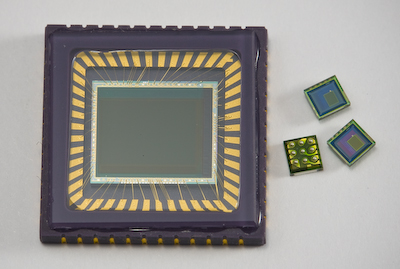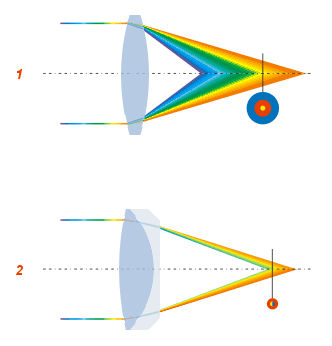|
Wavefront Coding
In optics and signal processing, wavefront coding refers to the use of a phase modulating element in conjunction with deconvolution to extend the depth of field of a digital imaging system such as a video camera. Wavefront coding falls under the broad category of computational photography as a technique to enhance the depth of field. Encoding The wavefront of a light wave passing through the camera system is modulated using optical elements that introduce a spatially varying optical path length. The modulating elements must be placed at or near the plane of the aperture stop or pupil so that the same modulation is introduced for all field angles across the field-of-view. This modulation corresponds to a change in complex argument of the pupil function of such an imaging device, and it can be engineered with different goals in mind: e.g. extending the depth of focus. Linear phase mask Wavefront coding with linear phase masks works by creating an optical transfer function that e ... [...More Info...] [...Related Items...] OR: [Wikipedia] [Google] [Baidu] |
Optics
Optics is the branch of physics that studies the behaviour and properties of light, including its interactions with matter and the construction of optical instruments, instruments that use or Photodetector, detect it. Optics usually describes the behaviour of visible light, visible, ultraviolet, and infrared light. Light is a type of electromagnetic radiation, and other forms of electromagnetic radiation such as X-rays, microwaves, and radio waves exhibit similar properties. Most optical phenomena can be accounted for by using the Classical electromagnetism, classical electromagnetic description of light, however complete electromagnetic descriptions of light are often difficult to apply in practice. Practical optics is usually done using simplified models. The most common of these, geometric optics, treats light as a collection of Ray (optics), rays that travel in straight lines and bend when they pass through or reflect from surfaces. Physical optics is a more comprehensive mo ... [...More Info...] [...Related Items...] OR: [Wikipedia] [Google] [Baidu] |
Ambiguity Function
In pulsed radar and sonar signal processing, an ambiguity function is a two-dimensional function of propagation delay \tau and Doppler frequency f, \chi(\tau,f). It represents the distortion of a returned pulse due to the receiver matched filter (commonly, but not exclusively, used in pulse compression radar) of the return from a moving target. The ambiguity function is defined by the properties of the pulse and of the filter, and not any particular target scenario. Many definitions of the ambiguity function exist; some are restricted to narrowband signals and others are suitable to describe the delay and Doppler relationship of wideband signals. Often the definition of the ambiguity function is given as the magnitude squared of other definitions (WeissWeiss, Lora G. "Wavelets and Wideband Correlation Processing". ''IEEE Signal Processing Magazine'', pp. 13–32, Jan 1994). For a given complex baseband pulse s(t), the narrowband ambiguity function is given by :\chi(\tau,f)=\int_^ ... [...More Info...] [...Related Items...] OR: [Wikipedia] [Google] [Baidu] |
OmniVision Technologies
OmniVision Technologies Inc. is an American subsidiary of Chinese semiconductor device and mixed-signal integrated circuit design house Will Semiconductor. The company designs and develops digital imaging products for use in mobile phones, laptops, netbooks, webcams, security, entertainment, automotive and medical imaging systems. Headquartered in Santa Clara, California, OmniVision Technologies has offices in the US, Western Europe and Asia. In 2016, OmniVision was acquired by a consortium of Chinese investors consisting of Hua Capital Management Co., Ltd., CITIC Capital and Goldstone Investment Co., Ltd. History OmniVision was founded in 1995 by Aucera Technology (TAIWAN:奧斯來科技). Some company milestones: * 1999: First Application-specific integrated circuit (ASIC) * 2000: IPO * 2005: Acquired CDM-Optics, a company founded to commercialize wavefront coding. * 2010: Acquires Aurora Systems and adds LCOS to its product line * 2011: Acquired Kodak patents * 2015: ... [...More Info...] [...Related Items...] OR: [Wikipedia] [Google] [Baidu] |
Commercialize
Commerce is the organized system of activities, functions, procedures and institutions that directly or indirectly contribute to the smooth, unhindered large-scale exchange (distribution through transactional processes) of goods, services, and other things of value at the right time, place, quantity, quality and price through various channels among the original producers and the final consumers within local, regional, national or international economies. The diversity in the distribution of natural resources, differences of human needs and wants, and division of labour along with comparative advantage are the principal factors that give rise to commercial exchanges. Commerce consists of trade and aids to trade (i.e. auxiliary commercial services) taking place along the entire supply chain. Trade is the exchange of goods (including raw materials, intermediate and finished goods) and services between buyers and sellers in return for an agreed-upon price at traditional (or onl ... [...More Info...] [...Related Items...] OR: [Wikipedia] [Google] [Baidu] |
University Of Colorado At Boulder
The University of Colorado Boulder (CU Boulder, CU, or Colorado) is a Public university, public research university in Boulder, Colorado, United States. Founded in 1876, five months before Colorado became a Federated state, state, it is the flagship university of the University of Colorado system. CU Boulder is a member of the Association of American Universities, considered a Public Ivy and is Carnegie Classification of Institutions of Higher Education, classified among R1: Doctoral Universities – Very high research activity. The university consists of nine colleges and schools and offers over 150 academic programs, enrolling more than 35,000 students as of January 2022. In 2021, the university attracted the support of over $634 million for research and spent $536 million on research and development according to the National Science Foundation, ranking it 50th in the nation. It receives the most NASA astrophysics technology grants of all academic institutions and is the only ... [...More Info...] [...Related Items...] OR: [Wikipedia] [Google] [Baidu] |
Thomas Cathey
Thomas may refer to: People * List of people with given name Thomas * Thomas (name) * Thomas (surname) * Saint Thomas (other) * Thomas Aquinas (1225–1274) Italian Dominican friar, philosopher, and Doctor of the Church * Thomas the Apostle * Thomas (bishop of the East Angles) (fl. 640s–650s), medieval Bishop of the East Angles * Thomas (Archdeacon of Barnstaple) (fl. 1203), Archdeacon of Barnstaple * Thomas, Count of Perche (1195–1217), Count of Perche * Thomas (bishop of Finland) (1248), first known Bishop of Finland * Thomas, Earl of Mar (1330–1377), 14th-century Earl, Aberdeen, Scotland Geography Places in the United States * Thomas, Idaho * Thomas, Illinois * Thomas, Oklahoma * Thomas, Oregon * Thomas, South Dakota * Thomas, Virginia * Thomas, Washington * Thomas, West Virginia * Thomas County (other) * Thomas Township (other) Elsewhere * Thomas Glacier (Greenland) Arts and entertainment * ''Thomas'' (Burton novel), a 1969 novel by Hes ... [...More Info...] [...Related Items...] OR: [Wikipedia] [Google] [Baidu] |
Edward Dowski
Edward is an English male name. It is derived from the Anglo-Saxon name ''Ēadweard'', composed of the elements '' ēad'' "wealth, fortunate; prosperous" and '' weard'' "guardian, protector”. History The name Edward was very popular in Anglo-Saxon England, but the rule of the Norman and Plantagenet dynasties had effectively ended its use amongst the upper classes. The popularity of the name was revived when Henry III named his firstborn son, the future Edward I, as part of his efforts to promote a cult around Edward the Confessor, for whom Henry had a deep admiration. Variant forms The name has been adopted in the Iberian peninsula since the 15th century, due to Edward, King of Portugal, whose mother was English. The Spanish/Portuguese forms of the name are Eduardo and Duarte. Other variant forms include French Édouard, Italian Edoardo and Odoardo, German, Dutch, Czech and Romanian Eduard and Scandinavian Edvard. Short forms include Ed, Eddy, Eddie, Ted, Teddy and Ned. ... [...More Info...] [...Related Items...] OR: [Wikipedia] [Google] [Baidu] |
Radar
Radar is a system that uses radio waves to determine the distance ('' ranging''), direction ( azimuth and elevation angles), and radial velocity of objects relative to the site. It is a radiodetermination method used to detect and track aircraft, ships, spacecraft, guided missiles, motor vehicles, map weather formations, and terrain. The term ''RADAR'' was coined in 1940 by the United States Navy as an acronym for "radio detection and ranging". The term ''radar'' has since entered English and other languages as an anacronym, a common noun, losing all capitalization. A radar system consists of a transmitter producing electromagnetic waves in the radio or microwave domain, a transmitting antenna, a receiving antenna (often the same antenna is used for transmitting and receiving) and a receiver and processor to determine properties of the objects. Radio waves (pulsed or continuous) from the transmitter reflect off the objects and return to the receiver, giving ... [...More Info...] [...Related Items...] OR: [Wikipedia] [Google] [Baidu] |
Stationary Phase Method
In mathematics, the method of steepest descent or saddle-point method is an extension of Laplace's method for approximating an integral, where one deforms a contour integral in the complex plane to pass near a stationary point (saddle point), in roughly the direction of steepest descent or stationary phase. The saddle-point approximation is used with integrals in the complex plane, whereas Laplace’s method is used with real integrals. The integral to be estimated is often of the form :\int_Cf(z)e^\,dz, where ''C'' is a contour, and λ is large. One version of the method of steepest descent deforms the contour of integration ''C'' into a new path integration ''C′'' so that the following conditions hold: # ''C′'' passes through one or more zeros of the derivative ''g''′(''z''), # the imaginary part of ''g''(''z'') is constant on ''C′''. The method of steepest descent was first published by , who used it to estimate Bessel functions and pointed out that it occurred in the ... [...More Info...] [...Related Items...] OR: [Wikipedia] [Google] [Baidu] |
Optical Aberration
In optics, aberration is a property of optical systems, such as Lens (optics), lenses and mirrors, that causes the ''image'' created by the optical system to not be a faithful reproduction of the ''object'' being observed. Aberrations cause the image formed by a lens to be blurred, distorted in shape or have color fringing or other effects not seen in the object, with the nature of the distortion depending on the type of aberration. Aberration can be defined as a departure of the performance of an optical system from the predictions of paraxial optics. In an imaging system, it occurs when light from one point of an object does not converge into (or does not diverge from) a single point after transmission through the system. Aberrations occur because the simple paraxial theory is not a completely accurate model of the effect of an optical system on light, rather than due to flaws in the optical elements. An image-forming optical system with aberration will produce an image which i ... [...More Info...] [...Related Items...] OR: [Wikipedia] [Google] [Baidu] |
Signal Processing
Signal processing is an electrical engineering subfield that focuses on analyzing, modifying and synthesizing ''signals'', such as audio signal processing, sound, image processing, images, Scalar potential, potential fields, Seismic tomography, seismic signals, Altimeter, altimetry processing, and scientific measurements. Signal processing techniques are used to optimize transmissions, Data storage, digital storage efficiency, correcting distorted signals, improve subjective video quality, and to detect or pinpoint components of interest in a measured signal. History According to Alan V. Oppenheim and Ronald W. Schafer, the principles of signal processing can be found in the classical numerical analysis techniques of the 17th century. They further state that the digital refinement of these techniques can be found in the digital control systems of the 1940s and 1950s. In 1948, Claude Shannon wrote the influential paper "A Mathematical Theory of Communication" which was publis ... [...More Info...] [...Related Items...] OR: [Wikipedia] [Google] [Baidu] |






